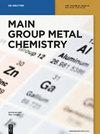Pt(0)P3, Pt(0)P4和Pt(II)P4 -畸变异构体的结构
IF 1.2
3区 化学
Q3 CHEMISTRY, INORGANIC & NUCLEAR
引用次数: 0
摘要
本文对P(0)P3、Pt(0) P4和Pt(II)P4衍生物畸变异构体的晶体学和结构参数进行了分析和分类。有些异构体不仅在变形程度上不同,而且在晶体类别上也不同。有三种类型的有机磷化氢,它们分别建立了关于铂原子的几何结构。在Pt(0)P3中,由三个单齿PPh3配体建立了一个扭曲的三角形平面几何。在Pt(0)P4中,由一对均匀双齿配体建立了具有不同程度畸变的四面体几何结构。在Pt(II)P4异构体中,由双齿P,P '供体配体建立了具有不同程度畸变的方形平面几何形状(除了一个异构体的例子,其中涉及四齿)。双齿-P,P ' -给体形成四-(PNP,PCP),五-(PC2P)和六-(PC3P)金属环。四齿形成5 -(PC2P)。Pt-P键距与金属环之间存在一定的协同效应,同时各自的几何变形增大。本文章由计算机程序翻译,如有差异,请以英文原文为准。
Structures of Pt(0)P3, Pt(0)P4 and Pt(II)P4 – Distortion isomers
Abstract In this review are analyzed and classified crystallographic and structural parameters of P(0)P3, Pt(0) P4 and Pt(II)P4 derivatives – distortion isomers. Some of the isomers are differing not only by degree of distortion but also by crystal class. There are three types of organo-phosphines which build up the respective geometry about the platinum atoms. In Pt(0)P3 a distorted trigonal planar geometry is build up by three monodentate PPh3 ligands. In Pt(0)P4 a tetrahedral geometry with various degree of distortion is build up by a pair of homo-bidentate ligands. In Pt(II)P4 isomers a square-planar geometries with various degree of distortion are build up by bidentate-P,P’donor ligands, (except one example of isomers, where a tetradentate is involved). The bidentate-P,P’-donor ligands form: four-(PNP,PCP), five-(PC2P) and six-(PC3P) metallocyclic rings. The tetradentate forms five-(PC2P). There are some cooperative effects between Pt–P bond distances and the metallocyclic rings, and at the same time a distortion of the respective geometry increases.
求助全文
通过发布文献求助,成功后即可免费获取论文全文。
去求助
来源期刊

Main Group Metal Chemistry
CHEMISTRY, INORGANIC & NUCLEAR-CHEMISTRY, ORGANIC
CiteScore
4.10
自引率
27.80%
发文量
21
审稿时长
4 weeks
期刊介绍:
This journal is committed to the publication of short communications, original research, and review articles within the field of main group metal and semi-metal chemistry, Main Group Metal Chemistry is an open-access, peer-reviewed journal that publishes in ongoing way. Papers addressing the theoretical, spectroscopic, mechanistic and synthetic aspects of inorganic, coordination and organometallic main group metal and semi-metal compounds, including zinc, cadmium and mercury are welcome. The journal also publishes studies relating to environmental aspects of these metals, their toxicology, release pathways and fate. Articles on the applications of main group metal chemistry, including in the fields of polymer chemistry, agriculture, electronics and catalysis, are also accepted.
 求助内容:
求助内容: 应助结果提醒方式:
应助结果提醒方式:


